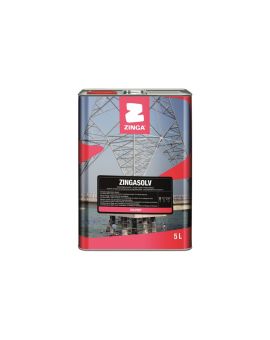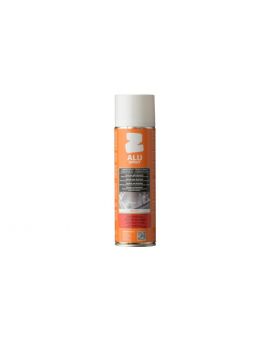£9.95 delivery on orders excluding certain products & postcodes *
Zinga 96% Zinc Cathodic Protection Galvanizing Paint
Zinga is a unique galvanizing paint system which can be used as an alternative to hot-dip galvanisation or metallisation that benefits from a 20 year product warranty. Suitable for application down to -15°C.
London Underground Approval No.423
Zinga Film Galvanising Coating System is a single pack coating that contains 96% zinc to provide cathodic protection of ferrous metals. Zinga can be used as an alternative to hot-dip metallisation, as a primer in a duplex system (active and passive) or as a recharging system for hot-dip galvanisation, metallisation or zinganised surfaces, Zinga can be applied on site, avoiding the need for dismantling ferrous metal structures, forming a grey matt, non-toxic finish. Zinga conforms to ISO standard 3549 in regard to its zinc purity of 99.995% and to ATM standard A780 in regard to its use as a repair coating for hot-dip galvanisation. Zinga can be overcoated with a compatible paint.
Best Uses
Use Zinga for the galvanising paint protection of ferrous metal structures such as bridges, a primer for boat keels, pylons, masts, street furniture, etc. Zinga is a longer lasting protection system compared to zinc rich primer or zinc phosphate primers. With correct preparation and application this cold galvanizing paint has an expected lifespan to first maintenance of 20 years.
ISO 12944
| System With Zinga | Alternative Paint System | Alternative Zinc and Paint System | |
| C4 High = C5 I/M Medium | Zinga 2 x 60 micron DFT | Paint min. 300 micron DFT | Hot Dip Galvanizisation 80 micron + Paint 160 micron DFT |
| C5 I/M High | Zinga 2 x 90 micron DFT Zinga in Duplex |
Paint min. 320 micron DFT | Hot Dip Galvanizisation 80 micron + Paint 320 micron DFT |
| Im2 and Im3 | Zinga 1 x 60-90 micron DFT Zinga in Duplex |
Paint min. 500 micron DFT | Zink (R) Paint 60 micron DFT + Paint 390 micron DFT |
As the paint top-coat naturally begins to break down and become porous over time, the Zinga fills the pores from below with zinc oxides enabling the top coat to last longer. Additionally, Zinga does not even start to sacrifice itself until the topcoat has become damaged to the point where it is exposing the bare zinc to the elements. It is because of this that we can state that the service-life of a duplex system can be 50% more than the sum of the individual lives of Zinga and the paint topcoat when added together.
Application
For full preparation instructions see product data sheet. Suitable for application down to -15°C.
ZINGA can be overcoated with a wide range of compatible paints. It is however, just like all Zinc rich systems sensitive to the influence of solvents. In order to avoid blistering, pinholes and other defects (which will negatively affect the performance of the ZINGA layer), it is advised to apply any topcoat with a mist/full coat technique. First, a thin continuous layer is applied which gives air bubbles easy passage through the film. The first mist coat also provides a barrier for aggressive solvents in the topcoat.
For overcoating this product, use Rustoleum Pegalink as a sealer coat prior to applying your chosen topcoat. Please note, that the application of a alkyd directly onto Zinga is not possible as the alkyd will not fully dry or cure.
Clean brushes and spray equipment using Zingasolv. If purchasing this product you will need to purchase Zingasolv as well.
What is the difference between Zinga and Paint?
Zinga is a high performance galvanizing coating for metal. Zinga containing zinc that works in conjunction with the metal substrates unlike paints that only offer a passive barrier. Regardless of the film thickness applied paint will only ever be a barrier unlike Zinga galvanizing coating that is an active coating. Once they are breached corrosion sets in immediately. Despite this significant difference Zinga is still thought of as a paint as it’s a liquid and is packaged in a tin. But there are other more subtle differences. Zinga does not “skin over” in the tin. Also, Zinga is a single pack product so offers an unlimited pot-life, and it doesn’t go “tacky” like a paint.
How Does It Work?
Cathodic protection arises from the anode, sacrificing itself in favour of the base metal, which allows the resulting flow of electrons to prevent the chemical reaction of the corrosion. This means that the protection of your metal is guaranteed, even when the zinc layer is damaged slightly. When you use Zinga, the sacrificial rate is reduced dramatically after the zinc layer has oxidised, and the natural porosity have been filled with zinc salts. Additionally, the zinc particles within the Zinga layer are protected by the 'organic binder' without negatively affecting the electrical conductivity of the metal. This allows Zinga to create nearly the same galvanic potential between the zinc and the steel as hot dip galvanising, but with a lower rate of zinc loss due to the fact that the binder acts as a sort of 'corrosion inhibitor' to the zinc.
Approvals
- Certified for use with potable water (BS 6290 2000)
- Certified as non-flammable (BS476 parts 6 & 7 : fire propagation and surface spread of flame)
- London Underground Approval No.423
- EN ISO 12944 - For new structural steel and repair of structural steel.
- Norsok M-501 System 1 (Pre Qualified)
- Norsok M-501 System 7C (Pre Qualified)
Notes
- A quick working rust preventive primer
- Zinga is a one pack coating containing 96% zinc
- Can be used as an alternative to hot-dip galvanising
- Can be overcoated with most topcoat systems
- Weldable with MIG or MMA process
- Highly resistant to mechanical abrasion
- Can be applied on top of existing galvanising, existing or damaged Zinc thermal spray or a previously applied layer of Zinga
- More than double the service life when used as part of a 2 stage system eg overcoated with powder or 2K paint products
- Able to be applied to damp surfaces in up to 90% relative humidity
- Can be applied in extreme temperatures from -15°C to + 40° C
- Longer protection than hot-dip galvanising applied to the same thickness
- Excellent adhesion over grit blasted steel
- Extreme flexibility - it will not crack or delaminate
- 96% Zinc content when dry providing full Cathodic protection
- ZINGA can be applied on a clean surface by brush and roller or conventional spray-gun or by airless spraying
- Suitable for on-site application
- For 120 μm DFT: 1,81 m2 per kg or 4,83 m2 per litre
- ZINGA must be thoroughly mechanically stirred to achieve a homogeneous liquid before application. After a maximum of 20 minutes, re-mixing is necessary.
Technical Info
| Components: | One Part |
| Type: | 96% Zinc |
| Finish: | Matt |
| Stock Colours: | Grey |
| Tintable: | No |
| VOC Content: | 474.0g per Litre |
| Volume Solids: | 80% |
| Suitable Substrates: | For suitably prepared metals |
| Application Method: | Brush, Roller, Conventional Spray or Airless Spray |
| Theoretical Coverage: | 9.67 m2 per litre at 60 microns |
| Wet Film Thickness (WFT): | - |
| Dry Film Thickness (DFT): | 60 - 120 microns |
| Induction Time: | - |
| Pot Life: | - |
| Touch Dry: | 15 minutes at 20°C for 40 microns |
| Overcoatable: | Application by brush: 2 hours after touch dry. Application by spray gun: 1 hour after touch dry. |
| Fully Cured: | 48 hours at 20°C for 40 microns |
| Cleaner / Thinner: | Zinga Zingasolv |
| Shelf Life: | Unlimited |
| Packaging: | Available in 1, 2 and 5 Kg |








